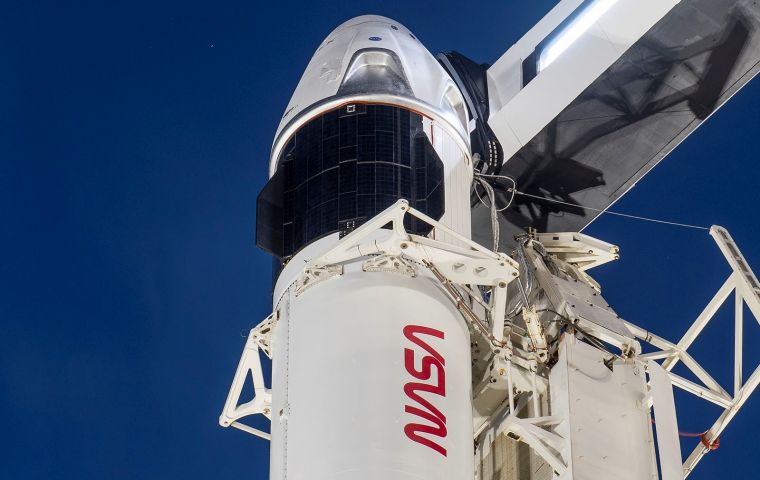MercoPress. South Atlantic News Agency
SpaceX successful launch to the Space Station with four astronauts in the Dragon capsule
 The Dragon capsule on top, named Resilience by its crew, reached orbit nine minutes after launch. It is due to reach the space station late Monday
The Dragon capsule on top, named Resilience by its crew, reached orbit nine minutes after launch. It is due to reach the space station late Monday SpaceX launched four astronauts to the International Space Station on Sunday on the first full-fledged taxi flight for NASA by a private company. The Falcon rocket thundered into the night from Kennedy Space Center with three Americans and one Japanese, the second crew to be launched by SpaceX.
The Dragon capsule on top — named Resilience by its crew in light of this year’s many challenges, most notably COVID-19 — reached orbit nine minutes later. It is due to reach the space station late Monday and remain there until spring.
“And Resilience rises ...,” a launch commentator announced at liftoff.
Sidelined by the coronavirus himself, SpaceX founder and chief executive Elon Musk was forced to monitor the action from afar. He tweeted that he “most likely” had a moderate case of COVID-19. NASA policy at Kennedy Space Center requires anyone testing positive for coronavirus to quarantine and remain isolated.
Sunday’s launch follows by just a few months SpaceX’s two-pilot test flight. It kicks off what NASA hopes will be a long series of crew rotations between the U.S. and the space station, after years of delay. More people means more science research at the orbiting lab, according to officials.
Cheers and applause erupted at SpaceX Mission Control in Hawthorne, California, after the capsule reached orbit and the first-stage booster landed on a floating platform in the Atlantic.
Moments before liftoff, Commander Mike Hopkins addressed the employees of NASA and SpaceX. “By working together through these difficult times, you’ve inspired the nation, the world, and in no small part the name of this incredible vehicle, Resilience,” he said. “And now it’s time for us to do our part.”
The flight to the space station — 27 1/2 hours door to door — should be entirely automated, although the crew can take control if needed. As the capsule settled into orbit, SpaceX reported pressure pump spikes in the capsule’s thermal control system, but flight controllers worked quickly to clear the issue.
With COVID-19 still surging, NASA continued the safety precautions put in place for SpaceX’s crew launch in May. The astronauts went into quarantine with their families in October. All launch personnel wore masks, and the number of guests at Kennedy was limited. Even the two astronauts on the first SpaceX crew flight stayed behind at Johnson Space Center in Houston.
Vice President Mike Pence, chairman of the National Space Council, traveled from Washington and joined NASA Administrator Jim Bridenstine to watch the launch.
“I didn’t start breathing until about a minute after it took off,” Pence said during a stop at SpaceX Launch Control to congratulate the workers.
Outside the space center gates, officials anticipated hundreds of thousands of spectators to jam nearby beaches and towns.
NASA worried a weekend liftoff — coupled with a dramatic nighttime launch — could lead to a superspreader event. They urged the crowds to wear masks and maintain safe distances. Similar pleas for SpaceX’s first crew launch on May 30 went unheeded.
The three-men, one-woman crew led by Hopkins, an Air Force colonel, named their capsule Resilience in a nod not only to the pandemic, but also racial injustice and contentious politics. It’s about as diverse as space crews come, including physicist Shannon Walker, Navy Cmdr. Victor Glover, the first Black astronaut on a long-term space station mission, and Japan’s Soichi Noguchi, who became the first person in almost 40 years to launch on three types of spacecraft.
They rode out to the launch pad in Teslas — another Musk company — after exchanging high-fives and hand embraces with their children and spouses, who huddled at the open car windows. Musk was replaced by SpaceX President Gwynne Shotwell in bidding the astronauts farewell.
Besides its sleek design and high-tech features, the Dragon capsule is quite spacious — it can carry up to seven people. Previous space capsules have launched with no more than three. The extra room in the capsule was used for science experiments and supplies.
The four astronauts will be joining two Russians and one American who flew to the space station last month from Kazakhstan.
The first-stage booster is expected to be recycled by SpaceX for the next crew launch. That’s currently targeted for the end of March, which would set up the newly launched astronauts for a return to Earth in April. SpaceX would launch yet another crew in late summer or early fall.
SpaceX and NASA wanted the booster recovered so badly that they delayed the launch attempt by a day, to give the floating platform time to reach its position in the Atlantic over the weekend following rough seas.




Top Comments
Disclaimer & comment rulesCommenting for this story is now closed.
If you have a Facebook account, become a fan and comment on our Facebook Page!